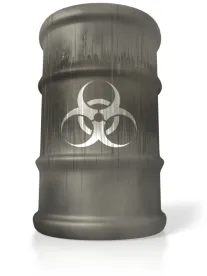The United States Environmental Protection Agency (“EPA”) has issued their long awaited guidance for petroleum vapor intrusion related to leaking underground storage tank (“UST”) sites. Authorized regulatory decision-makers (i.e., state agencies, tribal governments, etc. with authority to regulate leaking UST (LUST) sites) retain the discretion to oversee/accept protocols for addressing petroleum vapor intrusion (“PVI”) into indoor air for these sites.more
Volatile organic compounds (“VOCs”) are the type of contaminants responsible for most vapor intrusion and are generally divided into two categories:
• Petroleum hydrocarbons including non-petroleum hydrocarbon fuel additives, such as MTBE and tetraethyl lead, grouped together as PVI constituents.
• Chlorinated solvents such as carbon tetrachloride, tetrachloroethylene (“PCE”), trichloroethylene (TCE), and all other non-PVI constituents.
Vapor intrusion is the term for migration of VOCs from subsurface contamination in soil or groundwater through the soil into an overlying or nearby building.
Guidance for vapor intrusion from chlorinated solvents and other non-petroleum hydrocarbon or fuel additive VOCs is addressed by the EPA Office of Solid Waste and Emergency Response’s (“OSWER”) Technical Guide For Assessing And Mitigating The Vapor Intrusion Pathway From Subsurface Vapor Sources To Indoor Air (EPA June 2015).
PVI constituents generally biodegrade to harmless by-products,whereas chlorinated solvents may biodegrade with some intermediate products that are more toxic than the parent contaminants.
The EPA guidance for PVI provides screening based on the physical separation between the source VOCs and potential receptors. Releases of contaminants that include both petroleum constituents and non-petroleum constituents such as chlorinated solvents should be addressed under OSWER’s more general vapor intrusion guidance.
The EPA guidance recommends the following:
• Assessment and mitigation of immediate threats to safety following discovery of the subsurface release. Threats may include fire or explosion in addition to inhalation of VOCs. Once any threat to safety is mitigated, a site characterization should be performed. Data generated by the site characterization regarding the physical, biological and chemical systems should be used to develop a conceptual site model (“CSM”). The CSM is used as the basis to investigate the PVI and further measures necessary to evaluate potential risks to human health and ecological receptors.
• Site Characterization. The lateral inclusion zone is the area surrounding a contaminate source through which vapor phase contamination can enter a building. Perform the delineation of a lateral inclusion zone to focus the investigation on buildings within this area. The lateral distance is site specific; however, the effective lateral distance may be the same scale as the effective vertical distance (15 feet maximum). A greater lateral distance is generally warranted in the downgradient direction of the plume. It may be necessary to assess some nearby buildings to confirm the site characterization is valid.
• Determination of the vertical separation distance between the contamination and the building basement, foundation or slab, as appropriate, for each building within the lateral exclusion zone. The vertical distance is the thickness of clean, biologically active soil between the source of the PHC vapors and the lowest point of an overlying building. The recommended vertical separation distances are six feet for dissolved vapor sources (beneath a building of any size) and 15 feet for light non-aqueous phase liquid (“LNAPL”) beneath buildings up to 66 feet on the shortest side. If the vertical separation distance is met or exceeded, generally no further investigation for PVI is necessary unless a preferential pathway or a high-ethanol blend of gasoline is present. If there is a preferential pathway or a high-ethanol blend of gasoline present further delineation is required. If the separation distance is not met, collect either: 1) near-slab shallow soil samples paired with deep source soil gas samples; or 2) collect indoor air samples paired with sub-slab soil gas samples. If the building is larger than 66 feet on the shortest side or if near slab soil gas samples indicate conditions are not favorable for biodegradation, use the second option.
From a practical standpoint it can be difficult to accurately identify the vertical and lateral distances of contaminants in both soil and groundwater from buildings due to seasonal variations, physical limitations and other factors. These distance factors may be regarded as overly conservative by state regulatory agency personnel.
• Evaluation of the vapor source and attenuation of the volatile vapors. Many buildings will contain detectable concentrations of petroleum vapors and other VOCs whether or not contamination may be present beneath the building. The attenuation factor estimates the concentration of a chemical in indoor air from the concentration of that chemical in soil gas or groundwater beneath or near that building. Indoor air can be impacted by both indoor and outdoor sources. The relative contribution of contamination from PVI versus background sources can be determined by collecting indoor samples in conjunction with sub-slab or near-slab soil gas samples. Father investigation of background vapor impacts, including collection of outdoor air samples and other techniques, are available through the Interstate Technology & Regulatory Council (ITRC) and other sources.
The soil vapor attenuation factor is calculated from the results of the chosen pair or vapor samples to determine if there is a potential for PVI above applicable exposure limits.
• Assessment. EPA has developed the Vapor Intrusion Screening Levels (“VISL”) Calculator to screen VOC level concentrations for groundwater, soil (sub-slab and exterior), and indoor air to estimate the VI indoor air exposure values. The VISL includes target indoor air screening levels for long term exposures that considers potential cancer and non-cancer effects of vapor forming chemicals. The primary source of human health exposure data used for the VISL Calculator is EPA’s Regional Screening Levels (“RSLs”), which are regularly updated. The results from the VISL calculator may assist the regulatory agency with authority over the PVI investigation and/or the consultant performing PVI investigation in identifying buildings that may warrant further investigation and/or mitigation, as appropriate.
It should be noted that the VISL does not recognize lateral inclusion zones or vertical separation distances to determine if the screening may be applicable. Anyone using this screening method should consider this when developing their site assessment strategy.
Weather conditions can influence the characteristics of PHC vapor migration over time. Rainfall, variation in groundwater levels, temporal changes in temperature
• Mitigation of the PVI based on the site characteristics as appropriate for the building, contaminant concentrations and site geology.
EPA also identifies community engagement as another component in the guidance; however, the EPA acknowledges that there is no single correct approach to engage the potentially impacted community in cleanup decisions.




 />i
/>i

